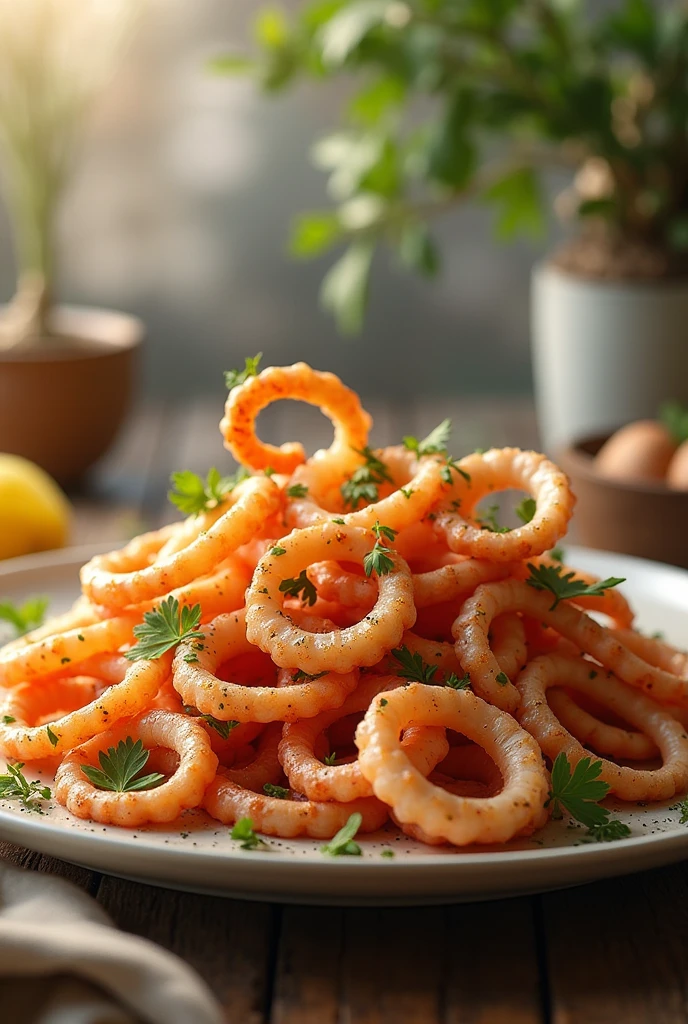
Greek calamari, or “kalamaris,” is a beloved dish in Greek cuisine that beautifully showcases the Mediterranean’s rich flavors and fresh ingredients. This dish features tender squid, often fried to perfection and served with a variety of dipping sauces, making it a popular appetizer or main course in Greek tavernas and restaurants around the world. Its popularity transcends borders, bringing a slice of Greece’s culinary heritage to dining tables everywhere.
History and Cultural Significance
The history of calamari is deeply intertwined with Mediterranean culture. Squid has been consumed since ancient times, with references to its use in various ancient texts. In Greece, calamari is often enjoyed during festive occasions, family gatherings, and seaside celebrations. The preparation of calamari varies across regions, reflecting local customs and seasonal ingredients.
In Greek culture, food is more than just sustenance; it’s a way to gather, celebrate, and share stories. Calamari often graces the tables during summer feasts, where families and friends come together to savor the flavors of the sea. Its inclusion in a meal signifies hospitality, a core value in Greek culture.
Preparation and Cooking Methods
The preparation of Greek calamari typically involves several key steps that highlight the dish’s fresh ingredients:
- Cleaning: Fresh squid is a must for the best flavor and texture. It is cleaned carefully, removing the entrails, beak, and skin. This meticulous process is crucial for ensuring a tender and palatable final dish.
- Cutting: The cleaned squid can be sliced into rings or left whole, depending on personal preference and presentation style. Rings are more common in fried preparations, while whole squid may be grilled or stuffed.
- Breading: The squid is often coated in a mixture of flour, salt, and pepper. Some recipes may include breadcrumbs or semolina for an extra crispy texture. This breading process helps create a delightful crunch when fried.
- Frying: The breaded squid is deep-fried in hot oil until golden brown and crispy, usually only a few minutes. This quick cooking method is essential, as it ensures the calamari remains tender inside while achieving a crispy exterior.
- Serving: Greek calamari is typically served hot, garnished with fresh lemon wedges and accompanied by a variety of dipping sauces like tzatziki or marinara. The presentation often includes a sprinkle of fresh herbs for added color and flavor.
Flavor Profiles
The flavor of Greek calamari is influenced by various ingredients that enhance its natural taste:
- Fresh Herbs: Oregano, parsley, and dill are common accompaniments, adding a fresh, aromatic quality to the dish. These herbs are often used in marinades or as garnishes.
- Citrus: Lemon juice is a classic addition, brightening the flavors and balancing the richness of the fried squid. The acidity of the lemon cuts through the oiliness, making each bite refreshing.
- Sauces: Tzatziki, made from yogurt, cucumber, and garlic, adds a creamy, refreshing element, while marinara sauce provides a spicy kick. The choice of sauce can dramatically change the overall flavor experience.
Variations
While the classic fried calamari is widely enjoyed, numerous variations exist throughout Greece and beyond:
- Grilled Calamari: Squid marinated in olive oil, lemon, garlic, and herbs can be grilled for a smoky flavor. This preparation emphasizes the natural taste of the squid while adding depth through charred notes.
- Stuffed Calamari: Squid tubes filled with a mixture of rice, herbs, and sometimes seafood or vegetables, then baked in a rich tomato sauce. This dish is hearty and showcases the versatility of calamari in different culinary contexts.
- Calamari Salad: In some regions, calamari is served cold in a salad, mixed with tomatoes, olives, and feta cheese, dressed with olive oil and lemon. This refreshing option highlights the Mediterranean’s emphasis on fresh, seasonal ingredients.
Pairing Suggestions
Greek calamari pairs well with various beverages, enhancing the dining experience:
- White Wine: A crisp, dry white wine, such as Assyrtiko from Santorini or a Sauvignon Blanc, complements the dish’s flavors beautifully. The acidity in the wine balances the richness of the fried squid.
- Ouzo: This anise-flavored aperitif is a traditional accompaniment, enhancing the Mediterranean experience. It is often served as an appetizer, making it a perfect match for calamari.
- Beer: A light, refreshing lager or a Mediterranean-style ale can also pair well, providing a crisp contrast to the dish.
Health Benefits
Calamari is not only delicious but also offers several health benefits:
- Lean Protein: Squid is a great source of lean protein, making it a healthy option for those looking to maintain or build muscle.
- Omega-3 Fatty Acids: Being a seafood option, calamari is rich in omega-3 fatty acids, which are beneficial for heart health.
- Low in Calories: When prepared without heavy sauces or excessive breading, calamari can be a low-calorie dish, making it suitable for various dietary preferences.
Greek calamari is more than just a seafood dish; it’s a celebration of Greek culture, culinary tradition, and the Mediterranean lifestyle. Whether enjoyed in a bustling taverna by the sea or prepared at home for a family gathering, this dish offers a taste of Greece that is hard to resist. Its simplicity, combined with fresh ingredients and rich flavors, makes it a favorite among seafood lovers everywhere. As you savor each bite, you experience not just a meal, but a connection to the vibrant culinary heritage of Greece.



